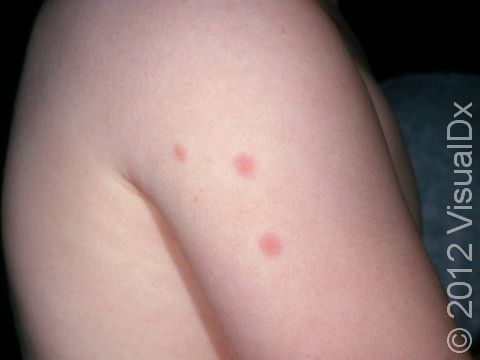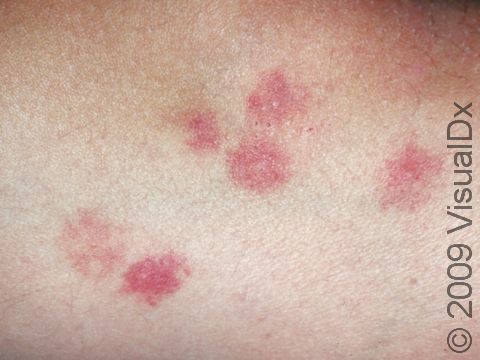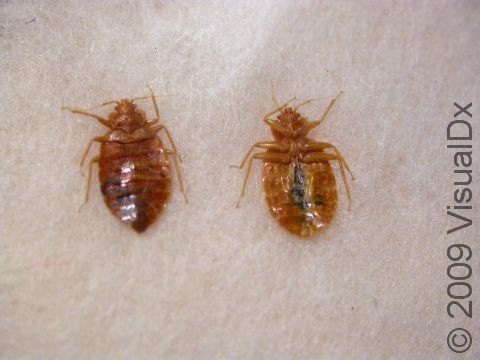Bedbug Bite
Bedbugs are very small (apple seed-sized) insects (Cimex lectularius) that feed on the blood of humans and other warm-blooded mammals. They live in dark, dry places such as mattresses, rugs, and upholstered furniture, and come out at dawn to feed by making small bites in their food source. The bite itself is painless, so children rarely wake up at the time of the bedbug bite, but the resulting bite leaves behind a highly allergenic (allergic-reaction causing) substance in the skin. This substance causes a very itchy rash in most people. Your child will awaken with a rash of scattered pink or red bumps or a welt. The bumps themselves are not dangerous, but children can get skin infections if they scratch and break the skin. Bedbugs probably do not cause the spread of blood-borne diseases.
Who's At Risk?
Bedbugs do not discriminate; anyone can be affected. Children may be at a higher risk of receiving bedbug bites if they are sleeping over at friends’ homes. In fact, children who sleep in multiple environments are more prone to bedbugs because they are exposed to more potential bedbug habitats. Bedbugs do not feed on trash or dirt, so untidiness and poor hygiene do not contribute to bedbug attacks. Bedbugs are most commonly found in highly populated areas.
Bedbugs can survive for up to a year without feeding, and they can be passed on in old furniture and mattresses.
Signs & Symptoms
Your child may complain of itching, but there may or may not be a visible bug bite. What start as small bruise-like areas turn into red bumps on the exposed parts of the body (arms, legs, chest, and sometimes the face). There may be a clustered configuration of 3 bites in a line (“breakfast, lunch, and dinner”). Resolution of the lesions takes about 2 weeks and may leave some darkening of the skin (post-inflammatory hyperpigmentation).
Children who are prone to eczema may develop a generalized bumpy redness in large areas with severe itching, and they may be tempted to vigorously scratch the affected areas. Scratching should be avoided, if possible, as it increases the risk for bacterial infection if scratching causes breaks in the skin.
You may see tell-tale signs of bedbug infestation such as blood stains on the sheets, flecks of bedbug dung on or around the bed, or smell a sweet odor that results from large numbers of bedbugs. You also may be able to spot a moving bedbug if you are searching at night.
Self-Care Guidelines
The mainstay of management of bedbug bites includes removing the bedbugs and controlling the itching.
The best time to look for live bedbugs is the middle of the night when they come out to feed. Wash all linens in hot water, and dry them in a hot dryer. You may also need to wash the curtains. Scrub furniture to remove eggs, and fix any cracks that may be in the furniture; you may need to take the furniture apart to properly do this. Vacuum the room, including the mattress (concentrating on the seams) and any surrounding crevices. You may want to fill and seal any cracks around the room and paste down any rolling wallpaper seams. Check the adjoining rooms for bugs as well, even if the occupants do not complain of itching.
Sometimes, in cases of severe infestation, it may be best to have a licensed pest control agent inspect and eradicate the bedbugs. Remember that some insect repellants can be toxic to children, so make sure to find out exactly what chemicals the agent will be using and what the chemical’s risk profile is.
Diphenhydramine (Benadryl®) can be used to control the itching, especially at nighttime. A low-strength topical corticosteroid cream or ointment, such as hydrocortisone, can be purchased over the counter to help with itching as well. Make sure to keep your child’s nails trimmed short to prevent breaks in the skin from scratching.
Treatments
Your child’s doctor may give him/her an antihistamine, such as Benadryl®, and/or topical corticosteroids to help reduce the itching and inflammation and reduce the possibility of infection caused by the child scratching. These might be especially helpful at night, to reduce the chances that the child will inadvertently scratch without realizing it. In rare cases of blistering skin reaction, oral corticosteroids may be necessary. If your child has a bacterial infection of the skin from scratching, he/she may need oral antibiotics. Rarely, anaphylaxis has occurred and is treated with emergency care.
Bedbug bites are difficult to visually diagnose. If your child is continuing to get lesions, the child’s doctor may need to take a small sample of skin (biopsy) to determine if he/she has some other skin condition.
Visit Urgency
Your child may need a prescription-strength topical steroid to help relieve intensely itchy bites. Children have an especially hard time refraining from scratching, especially at night. Because scratching may cause infection, look for tell-tale signs, such as pus, redness, swelling, or fever. If you see any of these signs or if there is blistering or an otherwise severe reaction, call your child’s doctor. There have been rare cases of severe allergic reaction that have affected breathing (anaphylaxis); if this is the case in your child, it necessitates immediate emergency medical care.
References
Ter Poorten, M, et al. The Return of the Common Bedbug. Pediatric Dermatology 22 (3), 183–187, 2005 May.
Last modified on August 16th, 2022 at 2:45 pm

Not sure what to look for?
Try our new Rash and Skin Condition Finder


